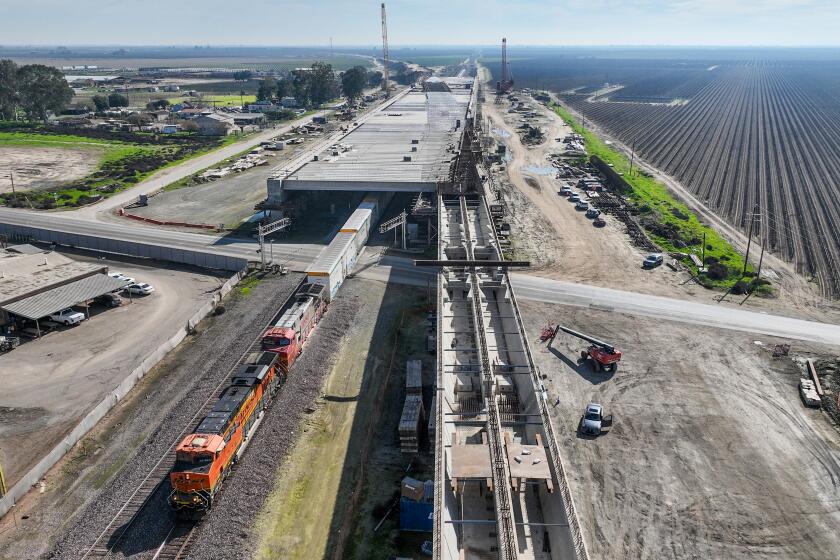Why Fight the Y? Motorist’s Solution Is as Easy as ABC
- Share via
Dear Street Smart:
I do not understand why Caltrans does not plan to extend one or more lanes of the San Diego Freeway past the El Toro Y, to Lake Forest Drive, El Toro Road or even to the new Bake Parkway. If extended, southbound San Diego Freeway traffic could reach these roads directly, without having to merge through I-5 traffic.
The longer Caltrans waits to discover this inevitable need, the more development will have occurred on the land that could be used for the extension.
Regardless of any plans to extend the I-5 south of the El Toro Y, as long as two freeways merge into one, there will be extensive congestion at that point. My suggestion for the crossover off-ramps would help alleviate some of that congestion.
David Melvoid, Irvine
To a degree, your suggestion will appear when Caltrans improves the interchange of Interstates 5 and 405, known as the El Toro Y, in a few years. Caltrans plans to build two special roads along either side of the interchange. These “collector-distributor” roads will keep traffic heading for nearby surface streets, outside of the main freeway flow.
For example, imagine a car heading southbound on the I-405 to Lake Forest Drive. Presently, the car must fight its way past the congestion where the I-405 and I-5 meet in order to reach the Lake Forest exit.
In the future, there will be a new Lake Forest exit on I-405 before reaching the freeway junction. Drivers can leave the freeway and follow a long road to Lake Forest without having to contend with El Toro Y congestion.
Also, traffic at the El Toro Y will gain by the early exit of drivers to local surface streets, which will free up more freeway space and reduce the number of motorists slowing to change lanes and exit, according to Camilo Rocha, a Caltrans engineer.
Work to improve the El Toro Y will begin in 1994 and should take about three years. The collector-distributor roads are at the heart of the project, but there will be other improvements. Among these will be direct connections from car-pool lanes on the I-5 to the I-405 and a new interchange with Bake Parkway.
*
Dear Street Smart:
I have encountered in Southern California, and in particular Huntington Beach, “delayed” left-turn arrows that appear only after through traffic has moved. This is very frustrating for drivers who are used to left-turn green arrows that appear before through-traffic goes. Would it be possible for cities to indicate on the left-turn sign, “Delayed Arrow” or “Advanced Arrow,” whichever the case may be?
Bernie Huot, Huntington Beach
At most intersections, traffic in a left-turn pocket is given a green arrow before through traffic is allowed to move, as you describe. However, there are a few intersections where it works better to have a green arrow after through traffic moves. Traffic engineers say this arrow “lags” behind the through traffic.
In Huntington Beach, lagging arrows are most noticeable at Beach Boulevard and Garfield Avenue, according to city traffic engineer Jim Otterson. He admits that lagging arrows can be confusing.
“Your natural tendency is, ‘Hey, there’s something wrong with the traffic signal. They missed the left turn,”’ Otterson said.
It would be convenient to have signs advising motorists about lagging left-turn arrows. However, such signs are not vital and would have the disadvantage of adding to the problem of sign proliferation, Otterson said.
“We’re finding now that there are so many signs on the street that people ignore all the signs and pay more attention to the stripes on the road,” Otterson said.
So what is required of a driver when confronted with this type of signal? Patience, Otterson said. If the arrow doesn’t appear before through traffic moves, have faith that one will eventually appear. That’s far more likely than an encounter with a malfunctioning signal, since the public usually informs officials of broken equipment right away.
“When there’s a malfunction like that and someone doesn’t get a signal for five minutes, I get messages on my voice mail, big time,” Otterson said.
*
Dear Street Smart:
Fullerton recently widened and improved Euclid Street from Valley View Drive north to Bastanchury Road. Before this work was done, and a lot of money spent, the speed limit was 45 m.p.h., the same as it is north of Bastanchury to the city limit.
Now the speed limit has been reduced to 35 m.p.h on the improved section. It is my observation that no one drives 35 through here. Is the city so in need of money that they hope to catch enough speeders to balance the budget?
Robert E. Huff, Fullerton
Fullerton Traffic Engineer Paul Smith swears it is not a speed trap. Instead, he said the speed limit was lowered after the improvement for safety reasons.
The old limit, which he said was 40 m.p.h., was reviewed and found too fast for that section of Euclid. The road has a lot of blind hills, where you can’t see over the hill’s crest as you drive. By lowering the limit to 35 m.p.h., the city felt it was increasing safety, Smith said.
Bypassing the El Toro Y
Future ramps alongside the El Toro Y interchange will funnel traffic around the junction to relieve congestion. Below, how southbound exits will work:
Bake Parkway / Lake Forest Drive Exit
Bake Parkway Exit
Lake Forest Drive Exit
Note: Freeway entrance ramps not shown
Source: Caltrans
More to Read
Sign up for Essential California
The most important California stories and recommendations in your inbox every morning.
You may occasionally receive promotional content from the Los Angeles Times.










